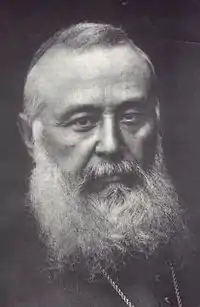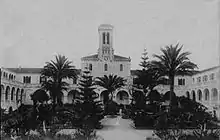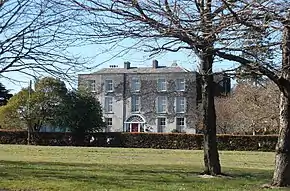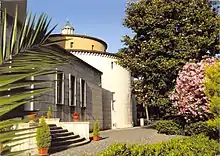White Fathers
The Missionaries of Africa, commonly known as the White Fathers or the Society of the Missionaries of Africa (French: Pères Blancs; post-nominals: M. Afr.) are a Roman Catholic society of apostolic life. Founded in 1868 by Archbishop of Algiers Cardinal Charles Lavigerie, the society focuses on evangelism and education, mostly in Africa. As of 2020, there were 1247 Missionnaires of Africa, of 36 Nationalities, working in 42 Countries, in 217 communities.[1]
Pères Blancs | |
 | |
| Abbreviation | M. Afr. |
|---|---|
| Formation | 1868 |
| Founder | Cardinal Charles Lavigerie |
| Founded at | Algiers |
| Type | Society of Apostolic Life of Pontifical Right (for Men) |
| Headquarters | Via Aurelia, 269, 00165 Roma, Italy |
Membership | 1,191 members (2019) |
Superior General | Fr. Stanley Lubungo, M. Afr. |
| Website | mafrome |
History

The cholera epidemic 1867 left a large number of Algerian orphans, and the education and Christian instruction of these children was the occasion of the founding of the society in Maison-Carrée (now El-Harrach) near Algiers; but from its inception the founder had in mind the conversion of the Arabs and the peoples of Central Africa. Lavigerie instructed his missionaries to speak the language of the people, eat the same food, and wear the same clothing. They therefore adopted the North African dress: the gandoura, the Arab cloak and the chechia, with as a religious sign a rosary worn around the neck like necklace.[1] The nickname "White Fathers" derives from their garb.
A novitiate was established in 1868. Missionary posts were established in Kabylie and in the Sahara. In 1876 three missionaries on their way to Timbuktu were killed by desert nomads.[1] In 1878 ten missionaries left Algiers to establish posts at Lakes Victoria, Nyassa and Tanganyika.[2] In 1878, a caravan of several missionaries arrived at the port of Mombasa, and after a three month trek reach Lake Victoria.
White Father missionaries in Algeria ransomed a young slave, Adrien Atiman, and arranged for his education.[3] Atiman subsequently became a medical catechist with the White Fathers at Karema, and was responsible for a significant autobiographical account of his enslavement, subsequent freedom and integration into the White Fathers' mission.[4]
In 1880, at the request of the Holy See, the White Fathers established at Jerusalem a Greek Melchite seminary for the formation of clergy of that rite. In 1894 a mission in French Sudan (now Mali) was founded.[2]
Present day
These now form the present Lakes Archdioceses of Kampala, Gitega, Tabora, and the dioceses of Kigoma, Lilongwe, and Kalemie-Kirungu.
The society is composed of missionary priests and brothers. The members are bound by an oath engaging them to labour for the conversion of Africa according to the constitutions of their society. The missionaries are not, strictly speaking, a religious institute, whether "order" or "congregation". Instead, they are a society of apostolic life. They may retain their own property; but they may expend it in the society only at the direction of the superiors.
Aims
One of the chief points in the rule is in regard to community life in the missions, each house being obliged to contain at least three members. At the head of the society is a General-Superior, elected every six years by the chapter. He resides in Rome at the Generalate house on Via Aurelia. Those desiring to become priests or brothers are admitted to the novitiate after their philosophical studies. After the novitiate they spent two years of missionary training on the field and four years of theology. This training can be slightly different for brother candidates. The theological studies are spent in scholasticate presently located in Abidjan (Ivory Coast), Nairobi (Kenya), Merrivale (Devon), South Africa and Jerusalem. The society admits persons of all nationalities.
Dress and membership
The habit of the missionaries resembles the white robes of the Algerian Arabs and consists of a cassock or gandoura, and a mantle or burnous. A rosary and cross are worn around the neck in imitation of the mesbaha of the marabouts.
The society depends directly on the Congregation for the Evangelization of Peoples. The White Fathers succeeded in establishing small missions among the Kabyle Berbers, there being at present nine hundred and sixty-two Christians; but the regions bordering on the Great Lakes and Sudan show the best results. The number of neophytes in all the vicariates (as of June 1909) was 135,000; the number preparing for baptism 151,480. A test of four years is imposed on those desiring to be baptized. To religious instruction the missionaries add lessons in reading and writing, and teach also, in special classes, the tongue of the European nation governing the country, which was mostly French in these areas. The brothers train the young people for trades and agriculture. The number of boys in the schools (June, 1909) was 22,281.

In January 2006, the society numbered; 9 bishops, 1,498 priests, 156 brothers; 16 clerics with perpetual oath, and 5 associates. There were 354 students preparing to enter the society.
Leaders
Under the leadership of Archbishop (later Cardinal) Charles-Martial Allemand-Lavigerie, General Superiors were:[5]
| 1874 | 1880 | Fr. Francisque Deguerry |
| 1880 | 1885 | Fr. Jean-Baptiste-Frézal Charbonnier (later Bishop) |
| 1885? | 1886 | Fr. Léonce Bridoux (later Bishop) |
| 1886 | 1889 | Fr. Francisque Deguerry |
| 1889 | 1894 | Bishop Léon Livinhac (later Archbishop) |

Later Superiors General were:[5]
| 1894 | 1922.11.11 | Archbishop Léon Livinhac |
| 1922 | 1936 | Fr. Paul Voillard |
| 1936.04.22 | 1947.04.30 | Bishop Joseph-Marie Birraux |
| 1947.05.05 | 1957 | Bishop Louis-Marie-Joseph Durrieu |
| 1957 | 1967 | Fr. Léon Volker |
| 1967 | 1974 | Fr. Théoz Van Asten |
| 1974 | 1980 | Fr. Jean-Marie Vasseur |
| 1980 | 1986 | Fr. Robert Marie Gay (later Bishop) |
| 1986 | 1992 | Fr. Etienne Renaud |
| 1992 | 1998 | Fr. Gothard Rosner |
| 1998 | 2004.06.02 | Fr. François Richard |
| 2004.06.02 | 2010.05.31 | Fr. Gérard Chabanon |
| 2010.05.31 | Fr. Richard Baawobr (became Bishop of Wa, Ghana, earlier in 2016) | |
| 2016.05.27 | Fr. Stanley Lubungo |
Zambia
The White Fathers also created mission stations in what was then Northern Rhodesia (now Zambia), particularly in the Luwingu District.
The Catholic Church in Zambia and the Missionaries of Africa (The White Fathers) (from the General House of the Missionaries of Africa - White Fathers)
The first Catholic Missionaries in what is now called Zambia were the international Society of the Missionaries of Africa, popularly called 'The White Fathers’ because of their white dress. They arrived from what is now called Tanzania in 1891, and established the first mission post called Mwambwe Mwela. They were hierarchically structured with Bishop Joseph Dupont firmly in charge , something that appealed to the Bemba overlords. One of the reasons that bloodshed was avoided was his reconciliation during one of their succession disputes. They settled down successfully in the North of what was then called Northern Rhodesia but did not follow those who migrated to the copper mines and the capital Lusaka during the 1930s. This practice was changed in 1965, after the Second Vatican Council, when a younger group of White Fathers responded to the national requirements of the apostolate. Around the beginning of the new millennium their missionary endeavour was taken over, almost entirely, by the local clergy.
See also

References
- Ceillier, Jean-Claude Ceillier. "The origins and Presentation of Our Society", Peres Blanc
- Forbes, John. "White Fathers." The Catholic Encyclopedia Vol. 15. New York: Robert Appleton Company, 1912. 3 March 2020
 This article incorporates text from this source, which is in the public domain.
This article incorporates text from this source, which is in the public domain. - Rockel, Stephen (16 April 2013). "The Remarkable Story of Adrian Atiman: Freed Slave to Medical Missionary". SSRN.
- "African history specialist discusses Adrien Atiman, freed slave to medical missionary". 14 March 2014. York University. Retrieved 18 August 2020.
- "Missionaries of Africa M. Afr". GCatholic. Retrieved 2013-04-19.
Herbermann, Charles, ed. (1913). . Catholic Encyclopedia. New York: Robert Appleton Company.